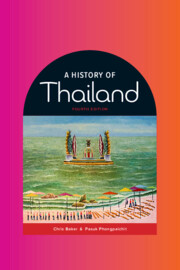113 results
Notes
-
- Book:
- A History of Thailand
- Published online:
- 13 April 2022
- Print publication:
- 07 April 2022, pp 335-352
-
- Chapter
- Export citation
Illustrations
-
- Book:
- A History of Thailand
- Published online:
- 13 April 2022
- Print publication:
- 07 April 2022, pp xi-xii
-
- Chapter
- Export citation
Glossary of names
-
- Book:
- A History of Thailand
- Published online:
- 13 April 2022
- Print publication:
- 07 April 2022, pp 353-362
-
- Chapter
- Export citation

A History of Thailand
-
- Published online:
- 13 April 2022
- Print publication:
- 07 April 2022
Chapter 3 - Reforms, 1850s to 1910s
-
- Book:
- A History of Thailand
- Published online:
- 13 April 2022
- Print publication:
- 07 April 2022, pp 51-89
-
- Chapter
- Export citation
Reigns and prime ministers
-
- Book:
- A History of Thailand
- Published online:
- 13 April 2022
- Print publication:
- 07 April 2022, pp 363-364
-
- Chapter
- Export citation
Chronology
-
- Book:
- A History of Thailand
- Published online:
- 13 April 2022
- Print publication:
- 07 April 2022, pp xix-xxii
-
- Chapter
- Export citation
Chapter 9 - Politics contested, 1970s to 2000s
-
- Book:
- A History of Thailand
- Published online:
- 13 April 2022
- Print publication:
- 07 April 2022, pp 259-296
-
- Chapter
- Export citation
Artist’s statement – cover image
-
- Book:
- A History of Thailand
- Published online:
- 13 April 2022
- Print publication:
- 07 April 2022, pp xxiii-xxiv
-
- Chapter
- Export citation
Chapter 2 - The old order in transition, 1760s to 1860s
-
- Book:
- A History of Thailand
- Published online:
- 13 April 2022
- Print publication:
- 07 April 2022, pp 28-50
-
- Chapter
- Export citation
Chapter 1 - Before Bangkok
-
- Book:
- A History of Thailand
- Published online:
- 13 April 2022
- Print publication:
- 07 April 2022, pp 1-27
-
- Chapter
- Export citation
Index
-
- Book:
- A History of Thailand
- Published online:
- 13 April 2022
- Print publication:
- 07 April 2022, pp 371-380
-
- Chapter
- Export citation
Copyright page
-
- Book:
- A History of Thailand
- Published online:
- 13 April 2022
- Print publication:
- 07 April 2022, pp iv-iv
-
- Chapter
- Export citation
Postscript
-
- Book:
- A History of Thailand
- Published online:
- 13 April 2022
- Print publication:
- 07 April 2022, pp 329-334
-
- Chapter
- Export citation
Abbreviations
-
- Book:
- A History of Thailand
- Published online:
- 13 April 2022
- Print publication:
- 07 April 2022, pp xiii-xiv
-
- Chapter
- Export citation
Readings
-
- Book:
- A History of Thailand
- Published online:
- 13 April 2022
- Print publication:
- 07 April 2022, pp 365-370
-
- Chapter
- Export citation
Chapter 7 - Ideologies, 1940s to 1970s
-
- Book:
- A History of Thailand
- Published online:
- 13 April 2022
- Print publication:
- 07 April 2022, pp 187-220
-
- Chapter
- Export citation
Chapter 6 - The American era and development, 1940s to 1960s
-
- Book:
- A History of Thailand
- Published online:
- 13 April 2022
- Print publication:
- 07 April 2022, pp 155-186
-
- Chapter
- Export citation
Preface
-
- Book:
- A History of Thailand
- Published online:
- 13 April 2022
- Print publication:
- 07 April 2022, pp vii-x
-
- Chapter
- Export citation
Acknowledgement of Country
-
- Book:
- A History of Thailand
- Published online:
- 13 April 2022
- Print publication:
- 07 April 2022, pp i-ii
-
- Chapter
- Export citation

